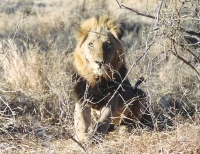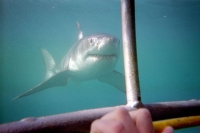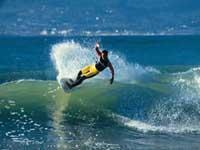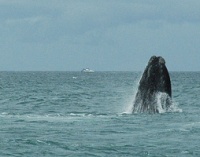
One of the biggest draws of visiting South Africa is the opportunity to go on safari. In fact, the world's image of the country almost always revolves around the famous Big Five (elephant, rhino, lion, leopard, and buffalo) set against the backdrop of a vast, diverse, and beautiful wilderness.Numerous game parks are scattered throughout South Africa. However, it is the oldest, largest, and most well-known wildlife conservation area, the Kruger National Park, which proves to be the destination of choice for most international visitors.Big Five viewing opportunities abound in many of the parks, and many private game reserves have the added attraction of being malaria-free, unlike the Kruger. There are many incredible creatures to seek out, apart from the Big Five.These animals include wild dogs, hyenas, cheetahs, baboons, numerous antelope species, warthogs, giraffes, zebras, hippos, crocodiles, ostriches, and monkeys, not to mention a wealth of birdlife. Parks offer guided walking tours, jeep safaris, and night drives, as well as self-drive safaris for those with their own vehicles.The parks have a variety of accommodation options, including world-class luxury game lodges and budget camp sites. Game viewing is possible year-round but many consider winter (June to August) the best season for safaris, as the animals tend to be easier to spot when the bush is less lush and dense.

While South African golf courses don't boast the history and prestige of their overseas counterparts, they are extraordinarily beautiful and unique. Indeed, combining big game viewing with the romance of the fairway makes for legendary rounds, immortalised in the memory.Many golf tour operators and safari operators focus on combining these two industries to craft a genuinely moving and surreal experience. It seems only fitting that the first course mentioned, Skukuza, is found in the country's best nature reserve, the Kruger National Park.Wildlife such as giraffe and wildebeest grace the landscape at the country's elite course, Leopard's Creek, which is also in national territory. The most scenic course, Cathedral Parks, wraps around lush and rugged African landscape.Apart from the allure of the wild, other highlights for those golfing in South Africa include the warm weather, relatively cheap green fees, and the technical merits of the courses. Cape Town, Johannesburg, and Durban all have great courses with ocean vistas and sweeping mountains.Cape Town visitors can mix golf vacations with other tourist attractions, such as famous beaches, nightlife, and nearby wine estates. A Jack Nicklaus signature course is playable nearby at Pearl Valley, while in Johannesburg, it is certainly worth travelling to Sun City and teeing off at the Gary Player Golf Course, designed by its namesake.The spectacular Garden Route makes for perhaps the best golf trips in South Africa. Already blooming with lush natural wonders, it harbours some memorable courses such as Fancourt, Arabella, Pearl Valley and Erinvale.

Diving with great white sharks is the experience of a lifetime. Numerous tour operators run cage diving trips around Gansbaai (two hours from Cape Town), where the open stretch of water between Dyer Island and the mainland is referred to as the shark diving capital of the world.Boat trips aim to educate people about the great white shark, and to provide an up close and personal encounter from within the safety of a cage lowered into the water. People can also watch and photograph sharks feeding at the surface alongside the boat.Those brave enough can then take turns inside the cage, which is let down about three feet (1m) below the surface of the water. Great white sharks are in Gansbaai all year round, but the highest densities occur during the winter months from May to October.The jury is out over the conservational impact of shark cage diving and whether the practice increases the likelihood of shark attacks due to the association of food with people. Travellers wanting to try out this exhilarating activity should be careful to do so with a well-known tour operator with plenty of experience.

South Africa offers world-class surfing opportunities, with two oceans (Atlantic and Indian) delivering grinding swells along the coast. This extends all the way from the Namibian border on the arid west coast to the Mozambique border at the far northern corner of the sub-tropical east coast.Surfers should pack 4mm wetsuits for the west coast, and 3mm wetsuits for the south and southeast coastlines. A shorty will suffice for the winter months along the Kwazulu-Natal coastline, as the waters of the Indian Ocean are generally quite warm.The West Coast extends from Cape Town up to the Namibian border and receives reasonably consistent Atlantic swells. The cold Benguela current dominates and it is common for surfers to wear a hoody and booties, particularly in the summer months when upwelling can bring surface water temperatures down to 53ºF (12ºC).Surfing spots abound in the vicinity of Cape Town and crowding is usually not a big factor. Key breaks include Llandudno, Noordhoek, Long Beach, Outer Kom, Kalk Bay, and Muizenberg. Muizenberg in particular is a tame wave, perfect for beginners.There are a number of surf schools located in Muizenberg and many amateurs and intermediate surfers frequent them. About three hour's drive up the west coast is Elands Bay, with its classic left-hand point break as well as some other good beach breaks in the vicinity.The Garden Route is blessed with great right-hand point breaks and warmer water than the west coast, due to the temperate Agulhus current flowing through the Indian Ocean. Surfing highlights dotted along this stretch of coast include Stilbaai, Mossel Bay, Victoria Bay, Cape St Francis and the famous Jeffrey's Bay (J-Bay). Together, they provide the perfect excuse for a road trip.They all have right-hand point break setups and are best visited in the winter months, when swells are more consistent and winds are more often offshore. Jeffrey's Bay is often regarded as the best right-hand breaking wave in the world, although surfers may well encounter crowding and fierce locals - of both the human and fish variety.The Wild Coast was known as the Transkei during the apartheid era, and extends from East London to the southern border of Kwazulu-Natal. As the name implies, the area is largely undeveloped and road access to the coast is generally poor.There are some epic and well-known right-hand point setups such as Coffee Bay and Ndumbe, but generally many of the spots are kept under wraps as secret reef and beach breaks for those willing to explore the region.The epicentre of the South African surfing industry is located in Durban, on the sub-tropical east coast. The area is bathed by the warm waters of the Mozambican current, meaning visitors can ditch their wetsuits. Surfers should expect crowds, though.Good beach breaks in the Durban area include New Pier and North Beach, while heavy reef breaks such as Cave Rock will test even the most experienced surfers in an area known as the Bluff. Further north, Umhlanga Rocks, Ballito and Richards Bay are all blessed with consistent waves in the winter months.

Every year from July to November, whales arrive along the southern coast of South Africa. The gentle giants travel thousands of miles to calve in the warm waters of protected bays, with some high vantage points serving as perfect locations for spying the enormous creatures.The heart of the Whale Coast is Hermanus, renowned as the best whale watching area in the country. Here, southern right whales inhabit Walker Bay, often within 33 feet (10m) of the shore. According to the Word Wildlife Fund, Walker Bay is one of the top 12 whale viewing destinations in the world.The Whale Coast stretches from the Western Cape, up the east coast, including spots along the Garden Route such as Mossel Bay, Knysna, Plettenberg Bay, and the Tsitsikamma National Park coastline.The De Hoop Nature and Marine Reserve is also popular during season for its Whale Trail: a five-day hiking excursion that offers fantastic whale-viewing opportunities along its coastal stretch. Companies offer boat trips too, giving animal lovers incredible close up experiences with these fantastic beasts.

The Western Cape produces some of the finest wines in the world. Visitors to the many historic estates can meet the winemakers and order wines shipped home at discounted rates. They can also enjoy cheeses, olives and fine food in the beautiful countryside.The main wine producing regions of South Africa are nestled together in this region, and most are accessible from Cape Town on a day trip. A key route is the R62, which covers world-renowned farms in Stellenbosch, Robertson, Franschoek, and Paarl.Groot Constantia and Boschendal serve as some of the oldest and most picturesque vineyards in the country. The former is a quick drive from the centre of Cape Town, while the latter is in the heart of Stellenbosch. Both are highly acclaimed.Nederberg in Paarl is one of South Africa's leading and most decorated wineries, winning numerous domestic and international awards. However, the still young Kleine Zalze in Stellenbosch is hot on its heels.The Swartland, Overberg, and Botrivier regions are all known for their distinctive Cabernet Sauvignon and spicy Shiraz, while the south coastal region is renowned for its crisp, dry Sauvignon Blanc due to the Atlantic sea breeze.Outside of the Cape, the eastern KwaZulu-Natal coast is new to the wine scene but is showing signs of promise. Some wonderful varietals come from the Orange River valley, where the river creates a cool microclimate that favours white wines.

Travel Guide powered by Word Travels, copyright © 2023 Globe Media Ltd. By its very nature information in this travel guide is subject to change at short notice and travellers are urged to verify information on which they're relying with the relevant authorities. Neither Globe Media Ltd nor Travel Vogue can accept any responsibility for any loss or inconvenience to any person as a result of information contained above.